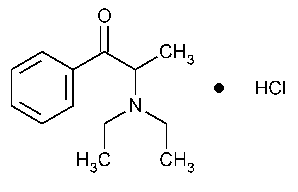Diethylpropion Hydrochloride
1-Propanone,2-(diethylamino)-1-phenyl-,hydrochloride.
2-(Diethylamino)propiophenone hydrochloride [134-80-5].
»Diethylpropion Hydrochloride contains not less than 97.0percent and not more than 103.0percent of C13H19NO·HCl,calculated on the anhydrous basis.It may contain tartaric acid as a stabilizer.
Packaging and storage—
Preserve in well-closed,light-resistant containers.
Labeling—
The label indicates whether it contains tartaric acid as a stabilizer.
Identification—
A:
Infrared Absorption á197Kñ.
B:
The retention time of the major peak in the chromatogram of the Assay preparationcorresponds to that of the Standard preparationas obtained in the Assay.
C:
Asolution (1in 100)responds to the tests for Chloride á191ñ.
Water,Method Iá921ñ:
not more than 0.5%.
Secondary amines—
Dissolve 100mg in 2mLof methylene chloride in a centrifuge tube.Transfer to a second tube 2mLof a Standard solution of diethylamine hydrochloride (dried at 105 for 2hours before being used)in methylene chloride having a known concentration of 250µg per mL.Treat each solution as follows.Extract with 2mLof a buffer solution containing 5.7g of sodium carbonate and 3.0g of sodium bicarbonate per 100mLof water.Centrifuge,if necessary,to clarify the upper phase,and immediately transfer 0.5mLof it to a spot plate.Immediately add 2drops of acetaldehyde TS,and then,in rapid succession,add 1drop of sodium nitroferricyanide solution (1in 100)to each spot.Immediately and simultaneously stir both spots to mix the reagents:any blue color produced within 3minutes by the test solution is not more intense than that of the Standard solution (not more than 0.5%of secondary amines as diethylamine hydrochloride).
for 2hours before being used)in methylene chloride having a known concentration of 250µg per mL.Treat each solution as follows.Extract with 2mLof a buffer solution containing 5.7g of sodium carbonate and 3.0g of sodium bicarbonate per 100mLof water.Centrifuge,if necessary,to clarify the upper phase,and immediately transfer 0.5mLof it to a spot plate.Immediately add 2drops of acetaldehyde TS,and then,in rapid succession,add 1drop of sodium nitroferricyanide solution (1in 100)to each spot.Immediately and simultaneously stir both spots to mix the reagents:any blue color produced within 3minutes by the test solution is not more intense than that of the Standard solution (not more than 0.5%of secondary amines as diethylamine hydrochloride).
Free bromine—
One drop of a solution (1in 10)produces no discoloration when placed upon starch iodide paper.
Limit of hydrobromic acid and bromide—
To 10mLof a solution (1in 10)add 1mLof sodium hydroxide solution (1in 10),extract with about 25mLof chloroform,and discard the chloroform extract.Add 1mLof 6Nhydrochloric acid,0.5mLof chloroform,and 0.5mLof freshly prepared chloramine Tsolution (1in 10),and shake vigorously:no yellow or brown-red color is produced in the chloroform layer.
Chromatographic purity—
Phosphate buffer—
Dissolve 136.1g of monobasic potassium phosphate in 900mLof water,add 3.2mLof phosphoric acid,dilute with water to 1000mL,and mix.
Diluent—
Prepare a mixture of water,Phosphate buffer,and acetonitrile (8:1:1).
Mobile phase—
Mix 100mLof acetonitrile,100mLof Phosphate buffer,7.0mLof diethylamine,and sufficient water to make 1liter.Filter,and degas before use.Make adjustments if necessary (see System Suitabilityunder Chromatography á621ñ).
Test preparation—
Transfer 100mg of Diethylpropion Hydrochloride,accurately weighed,to a 50-mLvolumetric flask,dissolve in about 40mLof Diluent,add Diluentto volume,and mix.
Standard preparation—
Dissolve an accurately weighed quantity of USP Diethylpropion Hydrochloride RSin Diluent,and dilute quantitatively,and stepwise if necessary,with Diluentto obtain a solution having a known concentration of about 0.01mg per mL.
System suitability solution—
Prepare a solution in Diluentcontaining about 25µg of 2-ethylaminopropiophenone hydrochloride and 50µg of USP Diethylpropion Hydrochloride RSper mL.
Chromatographic system
(see Chromatography á621ñ)—The liquid chromatograph is equipped with a 254-nm detector and a 4.6-mm ×15-cm column that contains packing L11.The flow rate is about 1mLper minute.Chromatograph the System suitability solution,and record the peak responses as directed for Procedure:the relative retention times are about 0.5for 2-ethylaminopropiophenone and 1.0for diethylpropion,and the resolution,R,between the 2-ethylaminopropiophenone and diethylpropion peaks is not less than 6.0.Chromatograph the Standard preparation,and record the peak responses as directed for Procedure:the relative standard deviation for replicate injections is not more than 1.0%.
Procedure—
Separately inject equal volumes (about 20µL)of the Standard preparationand the Test preparationinto the chromatograph,record the chromatograms,and measure the peak responses.The sum of all of the peak responses,excluding the solvent peak responses and the diethylpropion response,from the Test preparationis not greater than the diethylpropion response from the Standard preparation(0.5%).
Organic volatile impurities,Method Iá467ñ:
meets the requirements.
Assay—
Phosphate buffer—
Dissolve 136.1g of monobasic potassium phosphate in 900mLof water,add 4.3mLof phosphoric acid,dilute with water to 1000mL,and mix.
Mobile phase—
Prepare a suitable mixture of water,acetonitrile,Phosphate buffer,and 1.0Msodium nitrate (730:200:50:20),filter through a membrane filter (0.7-µm or finer porosity),and degas.Make adjustments if necessary (see System Suitabilityunder Chromatography á621ñ).
Standard preparation—
Dissolve an accurately weighed quantity of USP Diethylpropion Hydrochloride RSin Mobile phase,and dilute quantitatively,and stepwise if necessary,with Mobile phaseto obtain a solution having a known concentration of about 40µg per mL.
Assay preparation—
Transfer about 100mg of Diethylpropion Hydrochloride,accurately weighed,to a 250-mLvolumetric flask,dissolve in Mobile phase,dilute with Mobile phaseto volume,and mix.Transfer 10.0mLof this solution to a 100-mLvolumetric flask,dilute with Mobile phaseto volume,and mix.
System suitability preparation—
Prepare a solution in Mobile phasecontaining about 200µg of benzoic acid and 40µg of USP Diethylpropion Hydrochloride RSper mL.
Chromatographic system
(see Chromatography á621ñ)—The liquid chromatograph is equipped with a 254-nm detector and a 4-mm ×30-cm column that contains packing L1.The flow rate is about 1.5mLper minute.Chromatograph the System suitability preparation,and record the peak responses as directed for Procedure:the relative retention times are about 0.5for diethylpropion hydrochloride and 1.0for benzoic acid,and the resolution,R,between the diethylpropion hydrochloride and benzoic acid peaks is not less than 2.0.Chromatograph the Standard preparation,and record the peak responses as directed for Procedure:the relative standard deviation for replicate injections is not more than 1.0%.
Procedure—
Separately inject equal volumes (about 50µL)of the Standard preparationand the Assay preparationinto the chromatograph,record the chromatograms,and measure the responses for the major peaks.Calculate the quantity,in mg,of C13H19NO·HCl in the portion of Diethylpropion Hydrochloride taken by the formula:
2.5C(rU/rS),
in which Cis the concentration,in µg per mL,of USP Diethylpropion Hydrochloride RSin the Standard preparation,and rUand rSare the peak responses obtained from the Assay preparationand the Standard preparation,respectively.
Auxiliary Information—
Staff Liaison:Clydewyn M.Anthony,Ph.D.,Scientist
Expert Committee:(PA2)Pharmaceutical Analysis 2
USP28–NF23Page 633
Phone Number:1-301-816-8139
